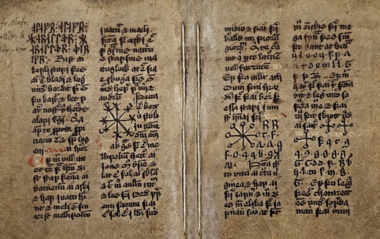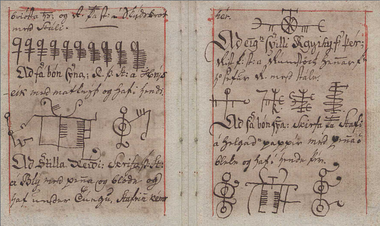Question
What is the oldest example of an Icelandic grimoire?
Asked By
Ritstjórn
Answer
The tradition of Icelandic galdrabækur developed in the so-called lærdómsöld (1550–1750), which – despite its name – was rather a period of superstition. The Reformation took place in Iceland before the middle of the 16th century and the Lutheran church was imposed by the Danish crown. From this moment on, the crown and the church determined what books may be read. In this climate, a popular culture, strongly influenced by superstition and magic, developed far away from the official institutions. At this time, the hunt for witches began on Iceland. In approximately half of the witchcraft trials (62 out of 130) that took place between 1554 and 1719, galdrastafir (also called galdramyndir) and galdrabækur are mentioned amongst the tools used to perform magic rites.[1] For this reason, one can imagine that during this period, many manuscripts were secretly burnt and destroyed by their owners in order to be safe from suspicion of practicing sorcery. The oldest specimen of a grimoire containing galdrastafir dates from the beginning of the 16th century. The manuscript AM 434a 12mo contains a medical book, written by two copyists, but only a fragment of this booklet survives.[2] It shows a clear connection with the tradition of the herbarium (Urtebog) written by the Danish scholar Henrik Harpestræng (†1244).[3] At the very beginning (fols 1r–6v), however, it contains an otherwise unknown supplement displaying galdrastafir, which is the oldest example of a Scandinavian grimoire combining textual and visual communication. [4] This is a collection of 47 randomly arranged spells giving an insight into magic practices. As the borders between ‘white’ and ‘black’ magic must often be considered as fluid, it is difficult to specify the kind of magic. As a matter of fact, a great number of charms are not meant to act against someone or something, but rather to provide protection for someone. They combine spells, magic charms, Christian prayers and formulae and practices for self-protection or for harming others, and they record a lot of different galdrastafir, as well as seals (insigli). Generally speaking, the function of all Icelandic grimoires was to protect one’s own person rather than harm others. They contain two kinds of charms: a first group was meant to assist the user in pursuing specific goals (e.g., becoming invisible, catching a thief, or winning a woman’s love); the second group are represented by the insigli, or ‘seals’, which like amulets, provided protection to the persons who carried them. Unlike the other galdrastafir, the seals display a geometrical form, mostly a round one, which closely resembles the shape of the well-known Vegvísir and ægishjálmur. Whilst some of the charms do not have any religious reference, some others display aspects of Christian superstition. The Icelandic examples had parallels on the Continent. Among the most popular works, known throughout Europe, we find Clavicula Salomonis, Corpus Hermeticum, De Occulta Philosophia, and The Sixth and Seventh Books of Moses. They all purport to contain ancient knowledge allegedly going back to the times of King Solomon or even the ancient god Hermes Trismegistos. Some of them offer instructions how to summon helping spirits or ward off evil demons, using potions, remedies or magical objects, how to make humans invisible, or to kill the livestock of one’s enemies. Unusual and rare ingredients (i.e., wool of the oldest castrated animal, bowels of a flatfish, wagtail tongues, skin of a freshly excavated corpse, and many others) should be collected (as well as pestled, burned, cooked, knotted together, or buried), often at distinct points in time like midnight, at a full or new moon, or at special feast days (such as Christmas, New Year’s day, or a particular Saint’s day). Astrology, alchemy, plant science, and medicine play a relevant role. Such books were printed despite the prohibitions imposed by the official church, and found a wide distribution nonetheless. www.handrit.is). However, these documents date from a much later period and appear to be copies of copies, yet showing a distinct affinity with the older tradition. The most comprehensive collection of galdrastafir is preserved in Lbs 2413 8vo, which dates from about 1800. This manuscript of uncertain provenance consists of 74 sheets. It lists about 200 examples of spells and charms; in each case, written text is closely connected with a visual element (galdramynd), and only the combination of the two parts produces meaning. The use of different kinds of writing systems was probably meant to amplify the effect of the charms. Considering that possession of such books represented a real danger for their owners, it is quite probable that many additional manuscripts were intentionally destroyed as a precaution. Footnotes:- ^ Cf. Magnús Rafnsson 2003, 15.
- ^ Text edition by Kålund 1907 (Den islandske lægebog).
- ^ This herbarium is a collection of 150 chapters concerning plants and their virtues. The best preserved manuscript containing this work dates from the 13th century.
- ^ ATA, Ämbetsarkiv 2, Vitterhetsakademiens handskriftsamling, serie F 16 volym 26, annotated editions by Lindqvist 1921; see also Flowers 2005.
Sources:
- Galdrabók = En Isländsk Svartkonstbok från 1500-talet. Udgiven med översättning och kommentar, ed. Natal Lindqvist. Uppsala: Appelberg 1921.
- The Galdrabók. An Icelandic Book of Magic, Second, revised edition, ed. Steven Flowers. Smithville: Samuel Weiser 2005.
- Galdrakver. Textaútgáfa Lbs 143 8º, ed. Emilía Sigmarsdóttir. Reykjavík: Háskólabókasafn 2004.
- Tvær galdraskræður. Lbs 2413 8vo, Leyniletursskræðan Lbs 764 8vo. Two Icelandic Books of Magic, ed. Magnús Rafnsson. Hólmavík: Strandagaldur 2008.
- Harpenstræng = Den islandske lægebog, ed. Kristian Kålund. Kjøbenhavn: A. F. Høst & Søn 1907.
- The Key of Solomon (Clavicula Salomonis), ed. Samuel Lidell McGregor Mathers, rev. by Joseph H. Peterson, 2005; http://www.esotericarchives.com/solomon/ksol.htm [accessed 15th October 2021]
- www.handrit.is [accessed 15th October 2021]
Literature:
- Bauer, Alessia (2020): “Biblical Magic as a Manifestation of Folk Belief in the North”. In: Kjesrud, Karoline/Males, Mikael (eds), Faith and Knowledge in Late Medieval & Early Modern Scandinavia (Knowledge, Scholarship, and Science in the Middle Ages 1), 251–287. Turnhout: Brepols.
- Magnús Rafnsson (2003): Angurgapi. The Witch-hunts in Iceland. Reykjavík: Strandagaldur.
- Matthías Viðar Sæmundsson (1992): Galdrar á Íslandi. Reykjavík: Almenna Bókafélagið.
- Ólafur Davidsson (1903): “Isländische Zauberzeichen und Zauberbücher”. In: Zeitschrift des Vereins für Volkskunde 13, 150–167, 267–279, pl. III–VIII.
- Óskar Halldórsson (1996): Bókmenntir á lærdómsöld (1550-1770). Reykjavík: Hið íslenska bókmenntafélag.
List of the Icelandic manuscripts containing galdrastafir:
- AM 247 8vo: 1790–1810, Copenhagen, different copyists (galdrastafir)
- AM 434a 12mo: c. 1500, Copenhagen, one copyist (lækningakver)
- AM 434d 12mo: 17th century, Copenhagen, one copyist (galdrakver)
- ATA Ämb. 2, F 16:26: 15th–17th centuries, Stockholm, different copyists (galdrakver)
- ÍB 179 8vo: 18th–19th centuries, Reykjavík, different copyists (galdrar)
- ÍB 383 4to: 1860, Reykjavík, one copyist (galdrakver)
- ÍB 663 8vo: 1780, Reykjavík, one copyist (vísdómsbók)
- ÍB 799 8vo: end of the 17th century, Reykjavík, one copyist (galdrar)
- JS 248 4to: 1846, Reykjavík, one copyist (galdrar)
- JS 313 8vo: 1750–1850, Reykjavík, different copyists (galdrar)
- JS 375 8vo: 1800–1820, Reykjavík, different copyists (galdrakver)
- JS 379 8vo: 18th–19th centuries, Reykjavík, different copyists (galdrar)
- Lbs 143 8vo: 1670, Reykjavík, one copyist (fragment of a galdrakver)
- Lbs 489 8vo: 18th–19th centuries, Reykjavík, different copyists (galdrar)
- Lbs 627 8vo: c. 1820, Reykjavík, one copyist (galdrakver)
- Lbs 764 8vo: 1780, Reykjavík, one copyist (galdrakver)
- Lbs 977 4to: 1818–1820, Reykjavík, one copyist (galdrakver)
- Lbs 1140 8vo: 1820, Reykjavík, one copyist (galdrakver)
- Lbs 1593 a 4to: 18th–19th centuries, Reykjavík, different copyists (galdrastafir)
- Lbs 1861–69 4to: 1859–1879, Reykjavík, one copyist (galdrasafn = collection of charms)
- Lbs 2413 8vo: c. 1800, Reykjavík, one copyist (galdrakver)
- Lbs 4375 8vo: 1900–1949, Reykjavík, one copyist (galdrakver)
- Lbs 4627 8vo: 19th century, Reykjavík, three copyists (galdrakver)
- Lbs 5472 I–III 4to: end of 19th century, Reykjavík, one copyist (galdrakver)
- AM 434 a 12mo | Digitized Manuscript Viewer | Handrit.is. (Accessed 15.06.2021).
- Lbs 2413 8vo | Digitized Manuscript Viewer | Handrit.is. (Accessed 15.06.2021).
Um þessa spurningu
Dagsetning
Published21.6.2021
Category:
Citation
Alessia Bauer. „What is the oldest example of an Icelandic grimoire?“. The Icelandic Web of Science 21.6.2021. http://why.is/svar.php?id=81995. (Skoðað 13.12.2025).
Author
Alessia Bauerprofessor of Scandinavian Studies at École Pratique des Hautes Études





